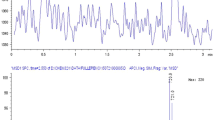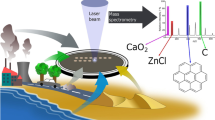Abstract
Fullerenes are interesting carbon nanomaterials with several forms of C60, C70, C76, and more molecules. However, little is known of the risk associated with their exposure. Inhalation is considered the most significant route of exposure to nanoparticles suspended in air, so we need suitable analytical methods of aerosol particles containing the fullerenes. Usually, fullerenes dissolved in organic solvents are analyzed by high performance liquid chromatography (HPLC) technique. For aerosol samples on filters, any extraction process must be conducted before HPLC analysis. In this study, we used a carbon aerosol analyzer for diesel exhaust particulates to determine fullerene amount in aerosol particles without any extraction process. The filter samples were directly analyzed by this instrument within half hour. Our method was applied for aerosols of C60 with dispersant, which was sampled from a whole body exposure chamber for rats. Inhalation study was conducted for 4 weeks, 5 days a week, 6 h a day, and one filter sample was obtained from more than 5 h sampling of 6 h exposure. Average concentration of 19 samples of C60 aerosols for 4 week inhalation was 0.12 ± 0.03 mg/m3 calculated from total aerosol mass and weight fraction of C60 and 0.13 ± 0.03 mg/m3 measured by the carbon aerosol analyzer. Minimum determination limit of this method was <1 μg for filter samples. The limit was a hundred times higher than the HPLC technique but better than the gravimetric method using microbalance for filter samples.






Similar content being viewed by others
References
Baker GL, Gupta A, Clark ML, Valenzuela BR, Staska LM, Harbo SJ, Pierce JT, Dill JA (2008) Inhalation toxicity and lung toxicokinetics of C60 fullerene nanoparticles and microparticles. Toxicol Sci 101(1):122–131
Bau A, Sorensen SN, Rasmussen RF, Hartmann NB, Koch CB (2008) Toxicity and bioaccumulation of xenobiotic organic compounds in the presence of aqueous suspensions of aggregates of nano-C60. Aquat Toxicol 86:379–387
Birch ME, Cary RA (1996) Elemental carbon-based method for monitoring occupational exposures to particulate diesel exhaust. Aerosol Sci Technol 25(3):221–224
Cadle SH, Mulawa PA (1990) Atmospheric carbonaceous species measurement methods comparison study: General Motors results. Aerosol Sci Technol 12:128–141
Cadle SH, Groblicki PJ, Stroup DP (1980) Automated carbon analyzer for particulate samples. Anal Chem 52(13):2201–2206
Chen HS, Kortan AR, Haddon RC, Fleming DA (1992) Thermodynamics of fullerene (C60) in pure oxygen, nitrogen and argon. J Phys Chem 96:1016–1018
Chow JC, Watson JG, Pritchett LC, Pierson WR, Frazier CA, Purcell RG (1993) The DRI thermal/optical reflectance carbon analysis system: description, evaluation and applications in U.S. air quality studies. Atmos Environ 27A(8):1185–1201
Dhawan JS, Taurozzi A, Pandey AK, Shan W, Miller SM, Hashsham S, Tarabara VV (2006) Stable colloidal dispersions of C60 fullerenes in water: evidence for genotoxicity. Environ Sci Technol 40:7394–7401
Endoh S, Maru J, Uchida K, Yamamoto K, Nakanishi J (2009) Preparing samples for fullerene C60 hazard tests: stable dispersion of fullerene crystals in water using a bead mill. Adv Powder Technol 20(6):567–575
Fujita K, Morimoto Y, Ogami A, Myojo T, Tanaka I, Shimada M, Wang W, Endoh S, Uchida K, Nakazato T, Yamamoto K, Fukui H, Horie M, Iwahashi H, Yoshida Y, Nakanishi J (2009) Gene expression profiles in rat lung after inhalation exposure to C60 fullerene particles. Toxicology 258:47–55
Gupta A, Forsythe WC, Clark ML, Dill JA, Baker GL (2007) Generation of C60 nanoparticle aerosol in high mass concentrations. J Aerosol Sci 38:592–603
Huntzicker JJ, Johnson RL, Shah JJ, Cary RA (1982) Analysis of organic and elemental carbon in ambient aerosol by a thermal-optical method. In: Wolff GT, Klimisch RL (eds) Particulate carbon: atmospheric life cycle. Plenum Press, New York, pp 79–88
Johnson RL, Huntzicker JJ (1979) Analysis of volatilizable and elemental carbon in ambient aerosols. In: Novakov T (ed) Proceedings of carbonaceous particles in the atmosphere, pp 10–13, Report LBL-9037. Lawrence Berkeley Laboratory, Berkeley, CA
King RB (1999) Chemical structure and superconductivity. J Chem Inf Comput Sci 39(2):180–191
Kroto HW, Heath JR, O’Brien SC, Curl RF, Smalley RE (1985) C60: Buckminsterfullerene. Nature 318:162–163
Methner MM, Birch ME, Evans DE, Ku B-K, Crouch K, Hoover MD (2007) Identification and characterization of potential sources of worker exposure to carbon nanofibers during polymer composite laboratory operations. J Occup Environ Hyg 4:D125–D130
Mochida I, Egashira M, Korai Y, Yokogawa K (1997) Structural changes of fullerene by heat-treatment up to graphitization temperature. Carbon 35(12):1707–1712
Mori T, Takada H, Ito S, Matsubayashi K, Miwa N, Sawaguchi T (2006) Preclinical studies on safety of fullerene upon acute oral administration and evaluation for no mutagenesis. Toxicology 225(1):48–54
Myojo T, Oyabu T, Nishi K, Kadoya C, Tanaka I, Ono-Ogasawara M, Sakae H, Shirai T (2009) Aerosol generation and measurement of multi-wall carbon nanotubes. J Nanopart Res 11(1):91–99
Nakanishi J (2008) Starategy to advance the NEDO project and results obtained in the last two years, Abstract book of international symposium on the risk assessment of manufactured nanoparticles, Tokyo, pp 26–30. http://www.aist-riss.jp/projects/nedo-nanorisk/nanorisk_symposium2008/download_e.html
NIOSH (1999) Method 5040 Issue 3 (Interim) elemental carbon (diesel exhaust) in NIOSH manual of analytical methods. National Institute of Occupational Safety and Health, Cincinnati, OH
Oberdorster E (2004) Manufactured nanoparticles (fullerenes, C60) include oxidative stress in the brain of Juvenile largemouth bass. Environ Health Perspect 112(10):1058–1062
Ono-Ogasawara M, Myojo T, Smith TJ (2008) A simple direct injection method for GC/MS analysis of PAHs in particulate matter. Ind Health 46(6):582–593
Ono-Ogasawara M, Serita F, Takaya M (2009) An approach to quantitative exposure assessment of nanomaterial particle. Distinction between nanomaterial particle and unintentional airborne particulate matter. J Nanopart Res 11(7):1651–1659
Sayes CM, Marchione AA, Reed KL, Warheit DB (2008) Comparative pulmonary toxicity assessments of C60 water suspensions in rats: few differences in fullerene toxicity in vivo in contrast to in vitro profiles. Nano Lett 7(8):2399–2406
Shimada M, Wang WN, Okuyama K, Myojo T, Oyabu T, Morimoto Y, Tanaka I, Endoh S, Uchida K, Ehara K, Sakurai H, Yamamoto K, Nakanishi J (2009) Development and evaluation of an aerosol generation and supplying system for inhalation experiments of manufactured nanoparticles. Environ Sci Technol 43(14):5529–5534
Shinohara N, Gamo M, Matsumoto T, Miyauchi A, Endo S, Yonezawa Y, Nakanishi J (2009) Is lipid peroxidation induced by the aqueous suspension of fullerene C60 nanoparticles in the brains of Cyprinus carpio? Environ Sci Technol 43(3):948–953
Turpin BJ, Cary RA, Huntzicker JJ (1990) An in situ time-resolved analyzer for aerosol organic and elemental carbon. Aerosol Sci Technol 12:161–171
Wilson LD, Cagle DW, Thrash TP, Kennel SJ, Mirzadeh S, Alford JM, Ehrhardt GJ (1999) Metallofullerene drug design. Coord Chem Rev 192:199–201
Xia XR, Monteiro-Riviere NA, Riviere JE (2006) Trace analysis of fullerenes in biological samples by simplified liquid–liquid extraction and high-performance liquid chromatography. J Chromatogr A 1129(2):216–222
Zakharian TY, Seryshev A, Sitharaman B, Gilbert BE, Knight V, Wilson LJ (2005) Synthesis, characterization, and study of biological activity in tissue culture. J Am Chem Soc 127(36):12508–12509
Acknowledgments
This research was funded by the New Energy and Industrial Technology Development Organization of Japan (NEDO) Grant “Evaluating Risks Associated with Manufactured Nanomaterials (P06041).”
Author information
Authors and Affiliations
Corresponding author
Rights and permissions
About this article
Cite this article
Myojo, T., Oyabu, T., Ogami, A. et al. Monitoring of C60 aerosol concentrations during 4-week inhalation study using a carbon aerosol analyzer with adjusted analytical protocol. J Nanopart Res 13, 2063–2071 (2011). https://doi.org/10.1007/s11051-010-9961-y
Received:
Accepted:
Published:
Issue Date:
DOI: https://doi.org/10.1007/s11051-010-9961-y




